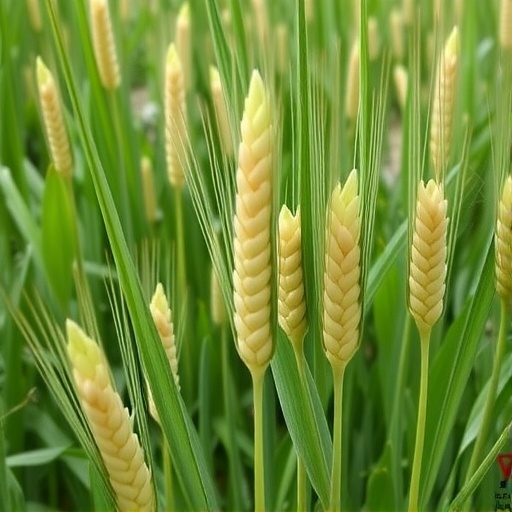In a groundbreaking study, researchers led by Sarkar, J., Yonzon, B.T., and Sarkar, S. delve into the agro-morphological characteristics and grain quality of mutant lines of Badshabhog rice, developed through ethyl methanesulfonate (EMS) mutagenesis. This innovative approach to crop improvement combines the principles of plant genetics and biotechnology, aiming to enhance both yield and grain quality. The findings of this extensive study not only contribute to our understanding of rice genetics but also offer practical applications in agricultural practices aimed at food security.
The study illuminates the potential of EMS mutagenesis as a powerful tool in plant breeding. By inducing mutations, researchers create genetic diversity within established cultivar populations, thus allowing the selection of superior traits. The Badshabhog cultivar, known for its traditional significance and adaptability, served as an ideal candidate for creating mutant lines that exhibit improved characteristics. This innovative method has significant implications for rice breeding programs, particularly in regions struggling with climate change and pest pressures.
EME mutagenesis involves treating seeds with the chemical agent ethyl methanesulfonate, which causes random mutations in the DNA. The effectiveness of this method lies in the ability to produce a wide range of genetic variations. These variations can manifest as alterations in plant morphology, growth patterns, and grain quality attributes. The study meticulously outlines the methodology, emphasizing how the careful selection of mutant lines can lead to advances in agricultural productivity.
Throughout the investigation, the researchers conducted rigorous assessments of various agro-morphological parameters. Traits such as plant height, tiller number, leaf length, and panicle architecture were evaluated systematically. Each of these traits plays a crucial role in determining the overall yield potential of rice varieties. For example, taller plants might be more susceptible to lodging, while a higher number of tillers can directly correlate with increased grain production. This detailed evaluation sheds light on the intricate relationships between plant morphology and yield.
In addition to assessing plant morphology, the research team meticulously analyzed grain quality parameters. Grain quality is paramount in determining the market value of rice and its acceptability to consumers. Traits such as grain length, width, weight, and cooking quality were evaluated using standardized testing methods. The findings indicated that certain mutant lines not only retained the desirable attributes of the original Badshabhog cultivar but also displayed enhanced quality features.
The researchers also highlighted the significance of identifying stable mutant lines. Stability in expression of desired traits across different environmental conditions is essential for commercial production. The study demonstrated how certain mutant lines exhibited consistent performance over multiple growing seasons, making them more suitable candidates for further breeding and cultivation. This stability is particularly important given the unpredictability of environmental factors that can affect crop production.
Further, the research has implications for food security, especially in regions where rice is a staple food. By improving yield and grain quality characteristics through mutagenesis, it is possible to enhance the nutritional value of rice and cater to the growing demands of the global population. The study’s findings could potentially lead to the development of new rice varieties that are more resilient to environmental stressors, thereby contributing to sustainable agricultural practices.
Sustainability in agriculture is a pressing issue, and this research directly addresses it. By using a relatively simple and cost-effective method like EMS mutagenesis, smaller farming operations can access improved varieties without the need for extensive biotechnological infrastructure. This democratization of crop improvement technologies promises to empower farmers and enhance food production in developing countries, where access to advanced agricultural techniques is often limited.
Additionally, this study serves as a reminder of the importance of traditional varieties in modern breeding programs. The Badshabhog cultivar’s noted adaptability and quality traits provide a rich genetic resource for enhancing the resilience and productivity of rice. Preserving these traditional varieties while integrating modern techniques offers a holistic approach to crop improvement, ensuring the continuity of genetic diversity in our food systems.
The implications of this research extend beyond rice cultivation. The principles of EMS mutagenesis and the insights gained from assessing agro-morphological and grain quality traits can be applied to other staple crops. This broader applicability underscores the potential for improving global food security through innovative breeding strategies that prioritize both yield and quality.
The collaborative efforts of the research team exemplify the importance of interdisciplinary approaches in tackling complex agricultural challenges. By combining expertise in genetics, agronomy, and data analysis, the researchers were able to conduct a thorough assessment that is both scientifically robust and practically relevant. Such collaboration is vital in the fast-evolving field of agricultural research, where multifaceted solutions are required to meet the needs of an ever-growing population.
In conclusion, the findings of Sarkar et al. represent a significant step forward in the field of agricultural science. The potential of EMS mutagenesis as a breeding tool to enhance the agro-morphological and grain quality traits of Badshabhog rice offers hope for improved food security and sustainability. As researchers continue to elucidate the genetic underpinnings of crop characteristics, the future of rice breeding looks promising. This study not only paves the way for further research but also provides invaluable insights relevant to farmers and stakeholders in the global agricultural community.
As this transformative research unfolds, its resonance will be felt across the agricultural landscape, fostering a renewed commitment to innovation and resilience in food production systems worldwide.
Subject of Research: Agro-morphological and grain quality parameters of Badshabhog mutant lines developed through EMS mutagenesis.
Article Title: Assessment of agro-morphological and grain quality parameters of Badshabhog mutant lines developed through EMS mutagenesis.
Article References:
Sarkar, J., Yonzon, B.T., Sarkar, S. et al. Assessment of agro-morphological and grain quality parameters of Badshabhog mutant lines developed through EMS mutagenesis.
Discov Agric 3, 214 (2025). https://doi.org/10.1007/s44279-025-00392-4
Image Credits: AI Generated
DOI:
Keywords: Rice, EMS mutagenesis, Badshabhog, Agro-morphology, Grain quality, Food security, Crop improvement, Sustainability, Genetic diversity, Plant breeding.
Tags: agro-morphological characteristicsBadshabhog rice mutantsbiotechnology in crop developmentclimate-resilient rice varietiescrop improvement techniquesEMS mutagenesis in ricefood security and ricegenetic diversity in agriculturegrain quality assessmentplant breeding innovationsrice genetics researchsustainable agriculture practices





